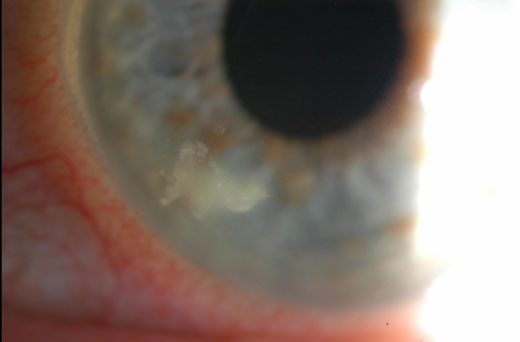 |
|
Some clinicians are hesitant when it comes to treating for MK. Photo: Suzanne Sherman, OD, and Christina Cherny, BS. Click image to enlarge. |
When making diagnostic decisions, there is almost always uncertainty, especially in cases of microbial keratitis (MK). A recent study aimed to understand corneal specialists’ diagnostic uncertainty by establishing risk thresholds for the treatment of MK that could be used to inform a decision curve analysis for prediction modeling.
The study included 72 ophthalmologists, of whom 50% were female with an average of 14.7 years of experience, 60% in academic practices and 38% outside the United States. Clinicians provided the percentage risk at which they would always or never treat MK (bacterial, fungal, herpetic, amoebic) based on initial ulcer size and location (<2mm2 central, <2mm2 peripheral and >8mm2 central).
Clinicians had a lower risk threshold for large central ulcers compared with small peripheral and small central ulcers, which didn’t surprise the authors. Corneal specialists had the lowest threshold when it came to always treating bacterial keratitis (20%, 25% and 10%, respectively), followed by herpetic (27.5%, 40% and 20%, respectively), fungal (50%, 50% and 30%, respectively) and Acanthamoeba (50.5%, 60% and 50%, respectively).
Differences were observed among uncertainty ranges for ophthalmologists practicing in the United States and internationally, specifically Acanthamoeba had the greatest range of uncertainty (53% vs. 46%), followed by fungal (40% vs. 17%), herpetic (13.5% vs. 17%) and bacterial (10% vs. 5%) MK.
“This could possibly be because Acanthamoeba and fungal infections are treated with very toxic medications as compared with bacterial infections. In addition to the medications being very toxic, they are needed for prolonged periods,” the authors noted. “This study also observed that international clinicians differed from US clinicians potentially due to different barriers to care and supported by previous research suggesting differences in practice patterns by region.”
“These findings suggest that ophthalmologists’ risk thresholds to always or never treat MK infections vary by organism types, size and location,” the authors concluded. “Between these risk thresholds to always and never treat MK infections is the range of diagnostic uncertainty. There is still a need for clinical judgment, but this diagnostic uncertainty range is where a DCA could be beneficial for showing value of prediction modeling and area of future exploration.”
Hicks PM, Singh K, Prajna NV, et al. Quantifying clinicians’ diagnostic uncertainty when making initial treatment decisions for microbial keratitis. Cornea. August 16, 2022. [Epub ahead of print]. |

